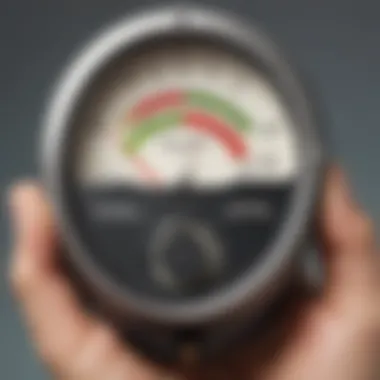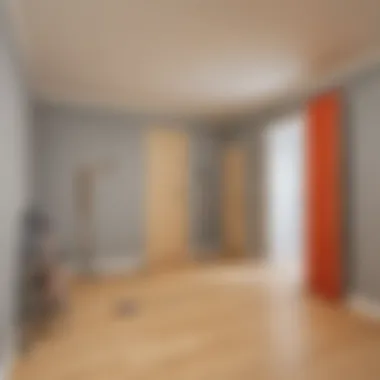Mastering Sound Decibel Testing: The Complete Guide for Precision Measurement


Science Fun Facts
As we embark on a journey to explore the intricate world of sound decibels, let's delve into some captivating science fun facts that will ignite our curiosity. Did you know that sound is a form of energy that travels in waves through various mediums such as air, water, and solids? Fascinatingly, the speed of sound differs depending on the medium it travels through, with air transmitting sound waves at around 343 meters per second. Additionally, sound waves can vary in frequency and amplitude, contributing to the different pitches and volumes we hear.
Sound decibels play a crucial role in our daily lives, influencing our auditory experiences and impacting our overall well-being. Amidst the cacophony of sounds surrounding us, understanding how to test sound decibels accurately is vital for ensuring a safe auditory environment. This ultimate guide aims to equip you with comprehensive knowledge and practical techniques to master the art of measuring sound levels effectively. Whether you're a sound enthusiast, a concerned parent, or a professional in the audio industry, honing your skills in testing sound decibels will empower you to create a harmonious sonic landscape.
From unraveling the fundamentals of sound decibels to exploring their applications in diverse settings, this guide will serve as your compass in navigating the realm of acoustic measurements. By shedding light on key concepts and methodologies, you will gain insight into the science behind sound decibels and learn how to wield this knowledge in real-world scenarios. Embrace the principles outlined here, and embark on a transformative journey towards becoming an adept sound level tester.
Stay tuned as we embark on a riveting exploration of sound decibels, unraveling their mysteries and unveiling practical methods to assess and interpret the auditory landscape around you. Join me in this enlightening quest to unlock the secrets of sound decibels and harness their power to shape the soundscape of tomorrow.
Introduction to Sound Decibels
In this article, we embark on an exploratory journey into the realm of sound decibels, shedding light on their significance and practical implications. The understanding of sound decibels is not merely an esoteric pursuit but a crucial aspect of ensuring safety and comfort in various environments. Through a nuanced examination of sound decibels, readers will grasp the intricacies of measuring and interpreting these audio signals. This section serves as a foundational cornerstone for delving deeper into the intricate world of sound decibels.
What are Sound Decibels?
Sound decibels represent the unit used to measure the intensity of sound waves. Think of it as a yardstick for sound volume, allowing us to quantitatively assess how loud or soft a sound is. By delving into the concept of sound decibels, we unravel the mystery behind the quantitative representation of noise levels. Understanding sound decibels paves the way for a nuanced comprehension of audio environments, emphasizing the importance of maintaining optimal sound levels for overall well-being.


Importance of Testing Sound Decibels
The significance of testing sound decibels cannot be overstated, as it forms the bedrock of ensuring auditory safety and quality. By assessing sound decibels, we gain insights into the acoustic landscapes we inhabit, enabling us to make informed decisions regarding noise exposure. Whether it pertains to safeguarding against hearing damage or optimizing sound levels for maximum efficiency, testing sound decibels plays a pivotal role in diverse fields such as healthcare, entertainment, and the industrial sector. Through meticulous testing of sound decibels, we pave the way for a harmonious auditory experience across various domains.
Understanding Sound Measurement
Understanding sound measurement is imperative in the realm of acoustics and sound engineering. This article segment delves into the intricacies of quantifying sound, emphasizing its significance in various applications.
Basics of Sound Waves
Sound waves are the fundamental medium through which sound travels. When an object vibrates, it creates mechanical disturbances in the air, resulting in the propagation of sound waves. Understanding the behavior of sound waves is essential for comprehending how sound is produced, transmitted, and perceived.
Decibel Scale Explained
The decibel scale is a logarithmic unit used to quantify sound intensity relative to a reference level. This section elucidates the concept of decibels, shedding light on how it measures the loudness of sound. By comprehending the decibel scale, one can grasp the relative quietness or loudness of a sound based on its decibel value.
Factors Affecting Sound Decibel Readings
Multiple factors can influence sound decibel readings, necessitating a nuanced approach to accurately measure sound levels. This subsection explores variables such as distance from the sound source, environmental conditions, and the presence of obstacles that may affect the recorded decibel levels. Understanding these factors is crucial for obtaining precise and reliable sound measurements.


Methods for Testing Sound Decibels
In this section, we delve into the crucial aspect of methods for testing sound decibels, a fundamental component of accurate sound level measurements. Understanding the significance of employing appropriate methods while testing sound decibels is paramount in ensuring precision and reliability in results. The meticulous selection of testing methods can significantly influence the outcome of sound level assessments, making it essential to choose the most suitable approach based on the specific context and desired outcomes.
When discussing methods for testing sound decibels, it is imperative to consider the diverse range of available techniques and tools that can aid in this process. From advanced decibel meters to manual testing methodologies, each method presents its unique advantages and considerations, catering to various settings and requirements. The integration of modern technological advancements in sound measurement devices has revolutionized the field, offering unprecedented accuracy and efficiency in capturing sound levels across different frequencies and environments.
Furthermore, the benefits of employing sophisticated decibel meters in sound level testing cannot be overstated. These specialized devices provide users with real-time data on sound intensity, frequency, and duration, enabling comprehensive analysis of environmental noise levels. By utilizing decibel meters, individuals can accurately monitor sound decibels in both indoor and outdoor settings, facilitating informed decision-making and proactive measures to mitigate excessive noise exposure.
Notably, the process of calibrating sound measurement devices plays a vital role in ensuring the reliability and accuracy of sound level assessments. Device calibration involves adjusting the internal settings of decibel meters to align with standardized references, thereby enhancing measurement precision and reducing potential errors. Regular calibration maintenance is essential to uphold the integrity of sound measurement instruments and uphold adherence to industry standards and regulatory requirements.
Moving beyond technological aids, manual sound decibel testing remains a valuable method for assessing sound levels in specific scenarios. While manual testing may lack the instant feedback and data visualization capabilities of electronic devices, it offers a hands-on approach to sound level assessment that can be tailored to unique environmental conditions. Conducting manual sound decibel testing involves actively listening for and evaluating sound intensity, enabling individuals to develop a keen ear for identifying variations in sound levels and potential sources of noise pollution.
Practical Applications of Sound Decibel Testing
In this section, we delve into the practical applications of sound decibel testing, a crucial aspect emphasized in our comprehensive guide on sound measurement. Understanding the practical implications of sound decibel testing is vital for ensuring a safe auditory environment in various settings, be it at home, work, or recreational spaces. By exploring this topic, readers will gain insights into how sound decibel testing can positively impact their daily lives.
Noise Pollution Monitoring
Noise pollution monitoring stands as a cornerstone of sound decibel testing, playing a fundamental role in safeguarding public health and well-being. It involves the continuous assessment of noise levels in urban and industrial areas to identify sources of excessive noise that could potentially harm individuals or disrupt communities. By meticulously measuring sound decibels in different environments, experts can mitigate the adverse effects of noise pollution and implement strategic measures to minimize its impact.


Industrial Noise Regulation Compliance
Industrial noise regulation compliance is another critical application of sound decibel testing. Industries must adhere to specific noise level standards to ensure the safety and health of their workers. By employing sound measurement techniques, organizations can accurately assess and control noise emissions within their facilities, mitigating the risk of occupational hearing loss and other related health issues. Compliance with industrial noise regulations is paramount for fostering a conducive work environment and upholding legal requirements.
Music and Entertainment Industry Standards
Within the music and entertainment industry, sound decibel testing plays a pivotal role in maintaining quality sound production while safeguarding the auditory health of performers and audiences alike. By monitoring sound levels during concerts, events, and studio recordings, professionals can prevent overexposure to high decibel levels that may lead to hearing damage. Adhering to industry standards for sound decibel levels ensures optimal audio experiences for listeners without compromising on safety and quality. Understanding and implementing sound decibel testing practices are integral to the success and longevity of the music and entertainment sector.
Interpreting Sound Decibel Measurements
In this section of the ultimate guide on how to test sound decibels, we delve deep into the critical aspect of interpreting sound decibel measurements. Understanding and interpreting sound decibels is paramount in various fields, from monitoring noise pollution to ensuring compliance with industrial regulations. By mastering the interpretation of sound decibel measurements, individuals can safeguard against hearing damage and create safer auditory environments.
Exploring the intricacies of sound decibel measurements unveils a universe of information that extends beyond mere numerical values. It provides insights into the intensity of sound waves and their potential impacts on human hearing. This section serves as a compass, guiding readers through the labyrinth of decibel readings and aiding in making informed decisions regarding sound levels.
The significance of interpreting sound decibel measurements lies in its practical applications. By grasping the implications of different decibel levels, individuals can take proactive measures to protect their hearing health. Moreover, interpreting sound decibel measurements aids in evaluating the effectiveness of noise control measures, thus contributing to a quieter and safer environment.
Within the realm of sound engineering, interpreting sound decibel measurements is akin to deciphering a musical score. Just as a conductor interprets cues from a musical piece to create a harmonious symphony, understanding decibel readings allows technicians to orchestrate sound levels effectively. This skill is indispensable in fields such as live event production, where maintaining appropriate sound levels enhances the audience's experience.
Conclusion
In concluding this comprehensive guide on sound decibel testing, it is crucial to emphasize the significant role that understanding sound levels plays in our daily lives. Whether in industrial settings, entertainment venues, or even at home, being able to measure and interpret sound decibels accurately is paramount for maintaining a safe and healthy auditory environment. By grasping the concepts outlined in this article, individuals can equip themselves with the knowledge and skills needed to make informed decisions regarding sound exposure and minimize the risks associated with excessive noise levels.
Key Takeaways
As we reflect on the key points discussed throughout this guide, several crucial takeaways emerge. Firstly, mastering the art of testing sound decibels is essential for both personal and professional applications. From monitoring noise pollution to ensuring compliance with industrial regulations, the ability to accurately measure sound levels can have far-reaching implications. Secondly, understanding the differences between dB SPL and dBA is vital in interpreting sound measurements correctly, avoiding misinformation and potential hearing damage. Lastly, the use of decibel meters and the calibration of measurement devices are foundational practices that contribute to the reliability and accuracy of sound decibel testing.







